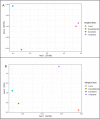Bacteria, yeasts, and fungi associated with larval food of Brazilian native stingless bees
- PMID: 36991089
- PMCID: PMC10060228
- DOI: 10.1038/s41598-023-32298-w
Bacteria, yeasts, and fungi associated with larval food of Brazilian native stingless bees
Abstract
Stingless bees are a diverse group with a relevant role in pollinating native species. Its diet is rich in carbohydrates and proteins, by collecting pollen and nectar supplies the development of its offspring. Fermentation of these products is associated with microorganisms in the colony. However, the composition of microorganisms that comprise this microbiome and its fundamental role in colony development is still unclear. To characterize the colonizing microorganisms of larval food in the brood cells of stingless bees Frieseomelitta varia, Melipona quadrifasciata, Melipona scutellaris, and Tetragonisca angustula, we have utilized molecular and culture-based techniques. Bacteria of the phyla Firmicutes, Proteobacteria, Actinobacteria, and fungi of the phyla Ascomycota, Basidiomycota, Mucoromycota, and Mortierellomycota were found. Diversity analysis showed that F. varia had a greater diversity of bacteria in its microbiota, and T. angustula had a greater diversity of fungi. The isolation technique allowed the identification of 189 bacteria and 75 fungi. In summary, this research showed bacteria and fungi associated with the species F. varia, M. quadrifasciata, M. scutellaris, and T. angustula, which may play an essential role in the survival of these organisms. Besides that, a biobank with bacteria and fungus isolates from LF of Brazilian stingless bees was created, which can be used for different studies and the prospection of biotechnology compounds.
© 2023. The Author(s).
Conflict of interest statement
The authors declare no competing interests.
Figures






References
-
- Michener, CD. The bees of the world. vol. 1 (JHU Press, 2000).
-
- Melo, G. Stingless Bees (Meliponini). Encyclopedia of Social Insects. (Springer, 2020).
-
- de Paula, G. T., Menezes, C., Pupo, M. T. & Rosa, C. A. Stingless bees and microbial interactions. Curr. Opin. Insect Sci. vol. 44 41–47 Preprint at 10.1016/j.cois.2020.11.006 (2021). - PubMed
-
- Kerr, W. E., Carvalho, G. A. & Nascimento, V. A. Abelha uruçu: biologia, manejo e conservacao. Manejo da Vida Silvestre (1996).
-
- Villas-Bôas, Jerônimo. Manual tecnológico: mel de abelhas sem ferrão (2012).
Publication types
MeSH terms
LinkOut - more resources
Full Text Sources
Medical

